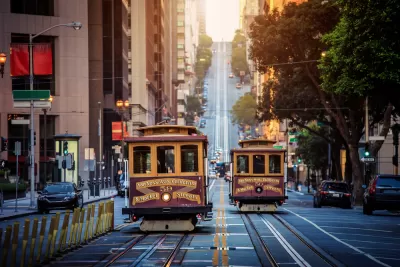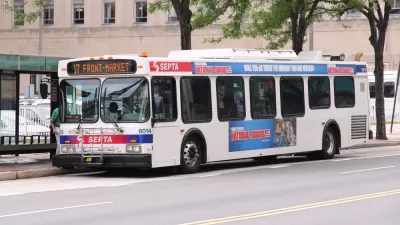The author of ‘The Great American Transit Disaster’ explains how U.S. transit agencies got to the existential crisis they face today.

In an interview in Bloomberg CityLab, David Zipper speaks with author Nicholas Dagen Bloom about his new book, The Great American Transit Disaster, in which Dagen Bloom describes how “US public transportation has lurched from one crisis to the next throughout the past century.”
Zipper writes, “Focusing on the histories of Atlanta, Baltimore, Boston, Chicago, Detroit and San Francisco, Bloom rejects the idea that there was anything preordained about the descent of private transit operators into bankruptcy or the decline in service offered by the public agencies that have operated buses and trains ever since.”
As Zipper notes, “It’s mind-blowing to consider just how good transit service once was.” In the early 20th century, transit was, Dagen Bloom adds, “a very profitable business,” but not for the reasons we might think. “The big money was always in the land development. Once the transit lines were built, the land was basically developed around them.”
While the rise of automobiles did have an impact on transit ridership, Dagen Bloom believes that “there was a whole series of compounding decisions made by city leaders, state leaders and private sector people” that led to the decline of transit systems. “You didn’t have to build systems of parkways and highways that were so comprehensive that you sacrifice neighborhoods. You didn’t have to completely demolish your downtowns, create massive federal programs that paid for parking ramps and give tax breaks on downtown parking.”
Ultimately, Dagen Bloom concludes, to save American transit, “someone’s got to fund transit” to pull agencies out of their current death spiral.
FULL STORY: Anatomy of an ‘American Transit Disaster’

Planetizen Federal Action Tracker
A weekly monitor of how Trump’s orders and actions are impacting planners and planning in America.

San Francisco's School District Spent $105M To Build Affordable Housing for Teachers — And That's Just the Beginning
SFUSD joins a growing list of school districts using their land holdings to address housing affordability challenges faced by their own employees.

The Tiny, Adorable $7,000 Car Turning Japan Onto EVs
The single seat Mibot charges from a regular plug as quickly as an iPad, and is about half the price of an average EV.

Seattle's Plan for Adopting Driverless Cars
Equity, safety, accessibility and affordability are front of mind as the city prepares for robotaxis and other autonomous vehicles.

As Trump Phases Out FEMA, Is It Time to Flee the Floodplains?
With less federal funding available for disaster relief efforts, the need to relocate at-risk communities is more urgent than ever.

With Protected Lanes, 460% More People Commute by Bike
For those needing more ammo, more data proving what we already knew is here.
Urban Design for Planners 1: Software Tools
This six-course series explores essential urban design concepts using open source software and equips planners with the tools they need to participate fully in the urban design process.
Planning for Universal Design
Learn the tools for implementing Universal Design in planning regulations.
Smith Gee Studio
City of Charlotte
City of Camden Redevelopment Agency
City of Astoria
Transportation Research & Education Center (TREC) at Portland State University
US High Speed Rail Association
City of Camden Redevelopment Agency
Municipality of Princeton (NJ)





























